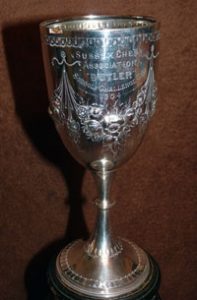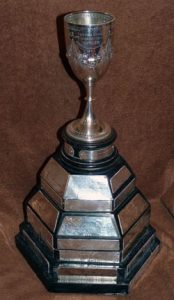Henry William Butler 1858-1935
The Butler Cup


In 1903 H.W. Butler announced that he was presenting a cup for Sussex schools. The competition ran initially between 1904 and 1911 but during that time was won by only two schools, the Municipal Secondary School, York Place, Brighton and the Belvedere School, Haywards Heath. After 1911 the competition lapsed for a number of years.
In 1921 the Butler Cup was restored, but in 1922 it became the trophy for younger secondary school teams. An anonymous donor had presented a cup for senior secondary teams. This was called the Wilson Cup and was the original Brighton Chess Club Championship trophy which had been won outright by W.V. Wilson in 1892.
SJC now award the Butler Cup to the first placed school in the Under-14 section of it’s inter-schools competitions.
Henry William Butler had a major influence upon Sussex chess for nearly fifty years. He was born in Brighton in 1858 and in 1877 first visited the Public Chess Room. He was one of the early enthusiasts who were determined to build up chess in the town. He spent many hours encouraging the spread of chess throughout Sussex and was instrumental in the formation of the Sussex Chess Association.
He was successful in his business life running a business called ‘Trick en Twig it’ (an anagram of ‘Ticket Writing’) which was concerned with the production of ornate notices, usually completed almost entirely by hand. In a resort like Brighton he would often produce ‘Bed and Breakfast’ cards. At one stage he employed upwards of fifty people in Brighton and Portsmouth.
However, in his spare time he was also a skilled journalist and administrator and used both talents to further chess in Brighton and Sussex.
He served as secretary of the Sussex Chess Association for several periods between 1888 and 1915, took a major part in organising the Brighton Congress of 1904, and formed the Sussex Chess Problem Fraternity in 1917 (under his tutelage the Fraternity became the British Chess Problem Society about a year later).
He wrote chess columns for the Brighton Guardian (from 1881) which were read not just locally but nationally, as the problem competitions were very popular and in 1919 he started an influential column in the Sussex Daily News under the pseudonym of ‘Chess Crusader’ which ran until 1928.
Perhaps his greatest legacy was the detailed archives of Sussex chess history which he left behind – a source which Brighton-based chess historian Brian Denman.
As a player he was probably at his peak in the late 1880s and early 1890s, competing amongst others against William Wilson. He was willing to experiment in the openings and his most famous innovation was the so-called ‘Butler’s folly’ consisting of 1.e4 e5 2.Bb5, though this line is not for the fainthearted!
In his family life he had four daughters and two sons. His devotion to chess is shown by the fact that he called his first child Caissa after the goddess of chess. His youngest son Gilbert went on to win the county championship in 1927 and his grandson Kenneth Gunnell played on board one in the Brighton Students team that won the McArthur Cup in 1937.
In 1928 he moved to Thornton Heath after playing chess in Sussex for over fifty years. The large sum of £55.13.0 was raised as a testimonial. His son Gilbert, who had recently won the Sussex Championship, went with him and both players joined the Battersea Club. Right up to his death in 1935 he never lost his enthusiasm for the game.